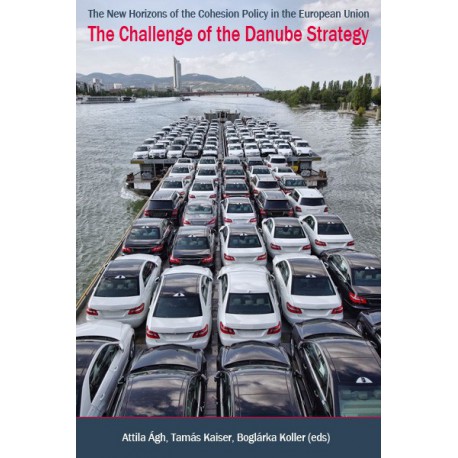暂无产品
价格含税
商品成功加入购物车
购物车有0件商品 购物车一件商品

PDF de prévisualisation.
Acheter le PDF pour une qualité optimale
More info
Table of contents
Preface
I. Cohesion in a new context
Danube Strategy and Europe 2020 Strategy: The organic link between the bottom-up
and the top-down EU projects Attila ÁGH
Introduction: the unfolding scenario of macro-regions
I. The Danube Saga: an age-old new vision for territorial integration
1. The macro-regions uploaded: the first steps
2. Danube Strategy reloaded: conflicts, expectations and illusions
II. Reinventing the macro-regions for the post-crisis world
1. The functional macro-regions in the globalising world
2. The territorial challenge from governance side: the functional macro-region
3. Territorial challenge from the policy side: “different is beautiful”
Conclusion: the DRS and the ongoing reform of the European Governance
References
Macro-regions and territorial cohesion: a case of an integrated approach Tamás KAISER
Introduction
1. Macro-regional strategies and territorial cohesion
2. Macro-regions in practice: policy interventions and debates
3. Integrated approach: wishful thinking or a case of an innovative governance?
4. Macro-regions in the making: seeking balances between coordination and governance
Conclusions
References
”Place -based” identities? Considerations on the re-territorialized identities in Europe
Boglárka KOLLER
Introduction
European identity and the evolution of the place-based approach
Territorial identities – theoretical considerations
People or place? Re-territorialisation of identities
A threat to European identity? – the boundary issues of re-territorialisation
Conclusions
References
Whom to empower in a multi-level system– acquainting Cohesion Policy in Central
Europe Judit KELLER
Introduction
Development, governance and institutional change
The Europeanization of Hungarian sub-national developmental governance
Variation in the transformation of micro-regional governance
Explaining variation in cases
Variation in institutional change
Variation in entrepreneurship
Variation in developmental dynamics
Conclusions
References
Agenda Setting and Institutional Design in the European Strategy for the Danube
Region - From Theory to Reality Jürgen DIERINGER and Johann-Jakob WULF
Macro-regional cooperation and the Danube
Background
Agenda setting and policy proposals
The ESDR polity: Agenda-setting, policy formation and adaptation phase
Conclusion
ReferencesOfficial documents
Macro-region or macro-regions in the Mediterranean area Anna MOLNÁR and Csilla
SIPOSS
Introduction
Euro-Mediterranean Partnership
One macro-region for the whole Mediterranean
More macro-regions in the area
Adriatic-Ionian macro-region
The Adriatic-Ionian Initiative
Priorities of the Adriatic-Ionian Initiative:
Latin Arch
Priorities
Conclusion
References
Regionalism, ENP Review and the Arab Spring Zoltán SIMON
Introduction: globalisation-cum-regionalisation and bilateralism versus multilateral regionalism in
EU Foreign Policy
The EU, its southern neighbourhood and the Arab Spring
The ENP review and the “new regionalism”
Conclusion: Six arguments for re-strengthening multilateral regionalism in the southern
Mediterranean
References
II. Case-studies
Critical Analysis of the EGTC Regulation: Will the European Border Regions have an
effective MLG-platform for territorial cooperation? Dániel HEGEDŰS
Introduction
1. The European and national experiences with the EGTC platform
2. The focal points of EGTC supervision on European level
3. National supervisions between 2007 and 2011
Conclusion
References
The possibilities of implementing the European Grouping of Territorial Cooperation in
South Transdanubia Zoltán PÁMER
Introduction
1. The evolution of the tools and institutions of territorial cooperation
2. EGTSs in Hungary
3. Characteristics of special structures in South Transdanubia – vectors of cross-border cooperation
4. An initiative from South Transdanubia: the Pannon EGTC
5. Experiences of Hungary–Slovenia–Croatia trilateral cooperation
Conclusions and recommendations
References
ANNEX
Tables
Maps
Figures
III. Research note
The Evolution of Cohesion Policy and Predictions for its Future between 2014 and 2020
Zsolt PÁLMAI and Lóránd BALÁZS
Introduction
Theoretical background
The most important stages of the evolution of the Cohesion Policy
The Cohesion Policy of the post 2013 period – a scenario based on real needs
Table 3 Probable CP scenario based on the real needs
Conclusions
References
IV. Communication from the YCDN
An example of the bottom-up approach of the Danube Region - The Young Citizens
Danube Network (YCDN) Johann-Jakob WULF and Juliane GIERACH?
Introduction
Young Citizens Danube Network (YCDN)
Pre – YCDN-Phase
Initiating Phase of YCDN – Danube Future Leaders’ Conference and 2nd Freiburg Summer
Academy
Initiating Phase of YCDN – Brussels and Ruse
Organising a youth conference “The young generation of the Danube area as a key to European
integration”
Timing of the conference
Young Citizens Danube Network Declaration Budapest 2011
Conclusion
References
Annex
Workshop A: National identity, myths and feeling
Workshop B: Protecting the environment in the Danube region
Workshop C: Building prosperity in the Danube region
Workshop D: Strengthening the Danube region
11 Other chapters in the same category
-

The Challenge Danube Strategy : Chapter 1
3,79 €
-

The Challenge Danube Strategy : Chapter 2
3,79 €
-

The Challenge Danube Strategy : 第3章
3,79 €
-

The Challenge Danube Strategy : 第4章
3,79 €
-

The Challenge Danube Strategy : 第5章
3,79 €
-

The Challenge Danube Strategy : 第6章
3,79 €
-

The Challenge Danube Strategy : 第7章
3,79 €
-

The Challenge Danube Strategy : 第8章
3,79 €
-

The Challenge Danube Strategy : 第9章
3,79 €
-

The Challenge Danube Strategy : 第10章
3,79 €
-

The Challenge Danube Strategy : 第11章
3,79 €









